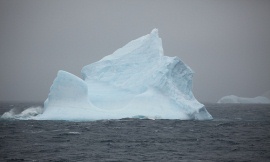THURSDAY, 01 DECEMBER 2011: ANTARCTIC CLIMATE AND ECOSYSTEMS COOPERATIVE RESEARCH CENTRE
— The Southern Ocean plays a critical role in global and regional climate. More than 90% of the extra heat energy stored by the planet in the past 50 years has been absorbed in the world’s oceans, with the Southern Ocean’s latitude band storing more heat and CO2 than any other latitude band.

The Southern Ocean is warming faster than the average for the global ocean. Image: Liam Q, Flickr CC-license
The Antarctic Climate and Ecosystems CRC has launched a synopsis of the latest scientific research into changes in the temperature, salinity, acidity and circulation in the Southern Ocean.
The Southern Ocean plays a critical role in global and regional climate. More than 90% of the extra heat energy stored by the planet in the past 50 years has been absorbed in the world’s oceans, with the Southern Ocean’s latitude band storing more heat and CO2 than any other latitude band. The synopsis, titled Position Analysis: Climate Change and the Southern Ocean, is a plain‐English summary of knowledge in this research area. The latest research shows
▪ The Southern Ocean is warming faster than the average for the global ocean.
▪ The warming extends to greater depth in the Southern Ocean than it does in low latitudesbecause of the unique ocean currents there that carry heat deep in the ocean. The large amount of heat stored in the ocean makes it expand, raising sea levels.
▪ These currents also carry large amounts of carbon dioxide into the deep ocean, slowing the rate of climate change. More than 40% of the carbon dioxide released by human activities that ends up stored in the ocean enters through the Southern Ocean.
▪ The Southern Ocean is getting fresher (lower in salinity). The changes in salinity provide evidence that the global water cycle is becoming more intense, with wet areas becoming wetter and dry areas becoming drier, as expected in a warming climate.
▪ Freshening is observed in the abyssal waters off Antarctica south of Tasmania, and in the intermediate depth waters that originate in the Southern Ocean.
▪ New measurements show that even the deepest waters, below 4 km depth, are warming and freshening. This means that even the deepest layers of the ocean can respond to changes in surface climate very quickly.
▪ The ocean is becoming more acidic, making it more difficult for a wide variety of organisms to build shells, skeletons and reefs.
▪ Because the effects of ocean acidification are sensitive to temperature, the threshold will be crossed first in the cold waters of the polar regions.
The report was prepared by the ACE CRC Oceans program leader Dr Steve Rintoul and the ACE CRC’s Professor Nathan Bindoff, who is a project leader within the Oceans program. Dr Rintoul said that understanding of the Southern Ocean and its role in the climate system had suffered from a lack of observations. “New technologies are allowing us to really measure the Southern Ocean for the first time, he said. “The changes we have observed in the temperature, salinity, sea level and carbon concentrations in the Southern Ocean are important because they tell us how and why the climate system is changing,” he said. “Because the Southern Ocean affects global and regional climate in profound ways, any changes in the region potentially have widespread consequences.”
Read more: http://sciencealert.com.au/news/20113011-22897.html
The Position Analysis defines the Southern Ocean as the area south of 30◦S.
Link to Position Analysis: Climate Change and the Southern Ocean